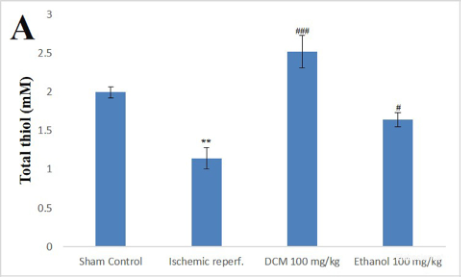Total Sulfhydryl Group/Total Thiol (-SH) Colorimetric Assay Kit
SKU: E-BC-K265-M-500
Total Sulfhydryl Group/Total Thiol (-SH) Colorimetric Assay Kit
| SKU # | E-BC-K261-M |
| Detection Instrument | Microplate reader (410 nm-420 nm, optimum wavelength: 412 nm) |
| Detection method | Colorimetric method |
Product Details
Properties
| Synonyms | T-SH |
| Sample type | Serum, plasma, animal tissue |
| Sensitivity | 9.91 μmol/L |
| Detection range | 9.91-1000 μmol/L |
| Detection Method | Colorimetric method |
| Assay type | Quantitative |
| Assay time | 20 min |
| Precision | Average inter-assay CV: 2.900% | Average intra-assay CV: 2.500% |
| Other instruments required | Micropipettor, Water bath, Incubator, Vortex mixer, Centrifuge |
| Other reagents required | Absolute ethyl alcohol |
| Storage | 2-8℃ |
| Valid period | 12 months |
Images
O A Afolabi et al evaluate the testicular torsion management with multiple method of treatment. Total sulfhydryl group (-SH) level in rat testicular tissue was determined using thiol colorimetric assay kit (E-BC-K265-M).

The level of total thiol was significantly changed by different type of treatment. (**P<0.01 vs. control, #P<0.05, ###P<0.001 vs. reperfusion injury)
Dilution of Sample
It is recommended to take 2~3 samples with expected large difference to do pre-experiment before formal experiment and dilute the sample according to the result of the pre-experiment and the detection range (9.91-1000 μmol/L).
The recommended dilution factor for different samples is as follows (for reference only):
| Sample type | Dilution factor |
| Human plasma | 4-6 |
| Human serum | 4-6 |
| Human urine | 1 |
| 10% Rat liver tissue homogenate | 4-6 |
| Rabbit serum | 3-5 |
| Porcine serum | 4-6 |
| 10% Rat kidney tissue homogenate | 4-6 |
| 10% Rat spleen tissue homogenate | 4-6 |
Note: The diluent is normal saline (0.9% NaCl).
Detection Principle
Sulfhydryl compounds react with 5,5' -dithiobis (2-nitrobenzoic acid) under neutral or alkaline conditions to produce a yellow product which have a maximum absorption peak at 412 nm. Measure the OD value and calculate the total mercapto content indirectly.
Kit Components & Storage
| Item | Component | Size 1 (96 T) | Storage |
| Reagent 1 | Buffer Solution | 20 mL× 1 vial | 2-8°C, 12 months |
| Reagent 2 | Chromogenic Agent | 1.3 mL× 1 vial | 2-8°C, 12 months shading light |
| Reagent 3 | Standard Powder | Powder × 2 vials | 2-8°C, 12 months |
| Microplate | 96 wells | No requirement | |
| Plate Sealer | 2 pieces |
Note: The reagents must be stored strictly according to the preservation conditions in the above table. The reagents in different kits cannot be mixed with each other. For a small volume of reagents, please centrifuge before use, so as not to obtain sufficient amount of reagents.
Technical Data:
Parameter:
Intra-assay Precision
Three human serum samples were assayed in replicates of 20 to determine precision within an assay. (CV = Coefficient of Variation)
| Parameters | Sample 1 | Sample 2 | Sample 3 |
| Mean (μmol/L) | 25.60 | 254.00 | 603.50 |
| %CV | 2.8 | 2.4 | 2.3 |
Inter-assay Precision
Three human serum samples were assayed 17 times in duplicate by three operators to determine precision between assays.
| Parameters | Sample 1 | Sample 2 | Sample 3 |
| Mean (μmol/L) | 25.60 | 254.00 | 603.50 |
| %CV | 3.0 | 2.6 | 3.1 |
Recovery
Take three samples of high concentration, middle concentration and low concentration to test the samples of each concentration for 6 times parallelly to get the average recovery rate of 104%.
| Parameters | Standard 1 | Standard 2 | Standard 3 |
| Expected Conc. (mmol/L) | 0.08 | 0.35 | 0.74 |
| Observed Conc. (mmol/L) | 0.1 | 0.4 | 0.8 |
| Recovery rate (%) | 101 | 105 | 106 |
Sensitivity
The analytical sensitivity of the assay is 9.91 μmol/L. This was determined by adding two standard deviations to the mean O.D. obtained when the zero standard was assayed 20 times, and calculating the corresponding concentration.
Standard Curve
As the OD value of the standard curve may vary according to the conditions of the actual assay performance (e.g. operator, pipetting technique or temperature effects), so the standard curve and data are provided as below for reference only:
| Concentration (mmol/L) | 0 | 0.05 | 0.1 | 0.2 | 0.4 | 0.6 | 0.8 | 1 |
| OD value | 0.078 | 0.141 | 0.216 | 0.358 | 0.647 | 0.922 | 1.219 | 1.486 |
| 0.077 | 0.142 | 0.213 | 0.358 | 0.649 | 0.921 | 1.214 | 1.474 | |
| Average OD | 0.078 | 0.142 | 0.214 | 0.358 | 0.648 | 0.922 | 1.216 | 1.480 |
| Absoluted OD | 0.000 | 0.064 | 0.136 | 0.281 | 0.570 | 0.844 | 1.138 | 1.402 |



